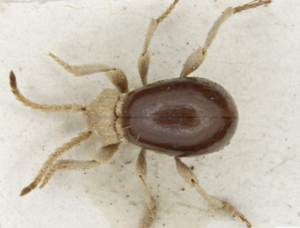 The common name comes from the spider-like appearance of the adults of many species. Spider beetles are a minor pest of stored products and are usually an indication of poor sanitation practices. They are distributed worldwide but are more common in the temperate regions which includes the United States. About 50 species are found in the United States and Canada, of which about 13 are pests.
The common name comes from the spider-like appearance of the adults of many species. Spider beetles are a minor pest of stored products and are usually an indication of poor sanitation practices. They are distributed worldwide but are more common in the temperate regions which includes the United States. About 50 species are found in the United States and Canada, of which about 13 are pests.
Adults are about 1/32-3/16″ (1-5 mm) long; they have a spiderlike, body usually oval, sometimes globular or elongate, with legs-and antennae usually long, thin, and covered with hairs.
Signs of damage and infestation are, round to slightly oval holes about 1/32-1/16″ (1-2 mm) maximum diameter in paper or cardboard enclosing larval food material or into firm material or wood for pupation. Presence of round (about 1/8″ or 4 mm in diameter) silken cocoons usually in larval food product, or on the outside of packaging, or on/in nearby materials.
Relatively few eggs, maybe up to 100 but often fewer, are laid in, on, or near larval food material. Larvae usually stay within the food material and go through 3 larval instars. They spin some silk, sometimes forming a feeding cell or cocoon. They spin a silken cocoon in which to pupate, with debris and food particles adhering to its surface. Larvae usually leave the food material to pupate and attach the cocoon to either the inside or outside surface of the packaging, or they may bore into nearby firmly textured material including wood. Adults often spend several days within the cocoon after emerging from the pupa. Adults usually live longer than their development period. Readily available water is required for maximum reproduction.
Spider beetles are primarily scavengers with many species feeding on both plant and animal origin materials. They feed on broken grain, grain products, seeds, dried fruits and meats, fish meal, wool, hair, feathers, skins, drugs, roots, rodent droppings, insect and other animal carcasses, and plant and animal museum specimens. They are especially attracted to moisture and to-the droppings of birds and mammals.
Besides being found in human food, warehouses, food-handling establishments, granaries, mills, museums, and homes, they are also found in the nests of bees, wasps, birds, mammals, and in bat caves and on dry carrion. Spider beetles tend to thrive best in wooden structures. Many species are active only at night, hiding in cracks, crevices, and voids during daylight. Some species can fly, others cannot. Some species are attracted to lights at night.
The presence of spider beetles usually indicates poor sanitation practices as well as poor product rotation.
A thorough inspection to locate infested product or materials is the key to control. This may be difficult since many spider beetle species wander about only at night and feed on a great variety of materials from food products to rodent droppings. Most avoid light and are hard to locate in cracks, crevices, and voids. Check for webbing, molt skins, and cocoons.
Control begins with good sanitation and product rotation. The elimination of infested materials is the primary control method.
Application of an appropriately labeled pesticide to surfaces over which the adults crawl can help with wettable powders a good choice, or dusts for voids. ULV applications made at night can help reduce the adult population.
Fumigations are usually only used for severe infestations in warehouses. However, a fumigation was recommended by the senior author for a heavily infested sorority house where the spider beetles were crawling on the residents inhabiting the top two floors while they slept at night. The infestation was traced to old rodent bait and rodent droppings in the attic, but adults and cocoons were abundant in the cracks of the wooden floors. Fumigation eliminated the problem.
